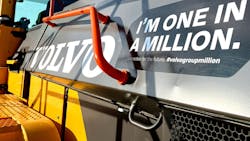Volvo surpasses one million connected customer assets worldwide
The more connected your trucks are, the more productive your fleet is. As the future of trucking becomes the present, Volvo says its connected trucks are making the industry more efficient, society safer and the environment cleaner.
The Volvo Group now has more than one million connected trucks, buses, and construction equipment gathering and delivering data across the world. That collected data, Volvo says, is improving productivity by increasing vehicle and machine uptime, reducing emissions and noise, improving traffic, and increasing safety.
“The connected solutions bring increased vehicle and construction equipment uptime for our customers, better safety for drivers, operators and other road users — and of course — less emissions of carbon dioxide,” said Martin Lundstedt, president and CEO of the Volvo Group. “The first million connected assets is only the start, we are committed to remain a leader in this field.”
On Oct. 3, Volvo handed over four electric excavators to Danish customer GSV Materieludlejning, which put the OEM over the one million connected equipment mark.
“This is a significant moment for the Volvo Group and we are happy to deliver machines that are not only robust and up for the job, but also come with connected solutions to make the customer’s everyday work easier,” said Jens Ejsing, managing director of Volvo Construction Equipment Denmark as he handed over the keys to Dan O. Vorsholt, CEO of GSV Materieludlejning.
The need for improved infrastructure and transportation of people and goods is growing as more people move into cities.
Last year, Volvo Trucks introduced a cloud-based service, Connected Safety, that allows Volvo trucks and Volvo cars to automatically alert each other to hazardous traffic situations.
In 2016, the passenger-car version of Connected Safety was launched by Volvo Cars, an independent vehicle manufacturer from Volvo Trucks. The truck OEM rolled out the program to its vehicles two years later. This is possible because the two companies share safety-related data between their respective clouds.
“The Volvo Group is a pioneer in connected vehicles and we use the knowledge and insights we get from connectivity in strategic alliances with customers and other partners to speed up the innovation cycle,” said Lars Stenqvist, chief technology officer at the Volvo Group.
Volvo Group uses data from connected vehicles and construction equipment to develop solutions for its customers and to the society at large, the company said in a news release.
The Volvo Group turns the data into insights that benefit the customers and support the areas of efficiency, safety and sustainability.
To improve sustainability and fuel-efficiency, Volvo offers data-driven, real-time coaching of drivers that could increase fuel-efficiency significantly. Drivers can be given feedback about the fuel-efficiency of their driving based on data from the vehicle. They can also be given suggestions on how to improve their driving or how to get the most out of the product. This increased understanding of customers can also be used in developing new vehicles and transport solutions.
When it comes to electromobility, it is not only a matter of building electrified vehicles and machines, according to Volvo. It is also a matter of taking steps on a societal level, for example developing infrastructure for power distribution. Charging a large vehicle or machine is different from charging a car, and the power grids are not adapted yet. But, the Volvo Group, says that the data from today’s connected customer assets could lead to better decisions on how to move forward in this area.
While the company admits there are still obstacles to overcome, connectivity creates more potential sustainable solutions within transportation.
Connected Volvo buses use Zone Management to let the vehicle itself use downloaded data to comply with local traffic restrictions such as emission zones, noise zones and areas with speed limits.
Volvo Trucks recently introduced dynamic maintenance, a connected vehicle maintenance service that seeks to improve fleet operations efficiency through proactive and flexible vehicle-specific maintenance planning. The company said it designed the service in partnership with Noregon Systems, an IoT company specializing in connected vehicle solutions.
Volvo said in September that its new dynamic maintenance service expands its partnership with Noregon and opens new capabilities with vehicle telematics. The new service uses existing connected technologies and data analytics, combined with Noregon’s platform, to enable customized service plans to an individual-vehicle level to help improve fleet operations efficiency.
This technology also focuses on uptime for trucks, buses and construction equipment. Thanks to the collected data, wear on crucial parts can be predicted, services planned and spare parts ordered in advance – all reducing downtime for the owner, thus leading to increased productivity.
The Volvo Connect system combines all digital and connected services for Volvo’s truck customers into one interface with the goal to make everyday trucking operations run smoothly.
In construction equipment, the fleet management system CareTrack allows customers and dealers to monitor productivity data.
“Connectivity is transforming the transportation industry. Insights from gathered data can be turned into value for our customers and society as a whole and make transportation more productive, more sustainable and safer”, says Anna Westerberg, senior vice president at Volvo Group Connected Solutions.
About the Author
Josh Fisher
Editor-in-Chief
Editor-in-Chief Josh Fisher has been with FleetOwner since 2017. He covers everything from modern fleet management to operational efficiency, artificial intelligence, autonomous trucking, alternative fuels and powertrains, regulations, and emerging transportation technology. Based in Maryland, he writes the Lane Shift Ahead column about the changing North American transportation landscape.


